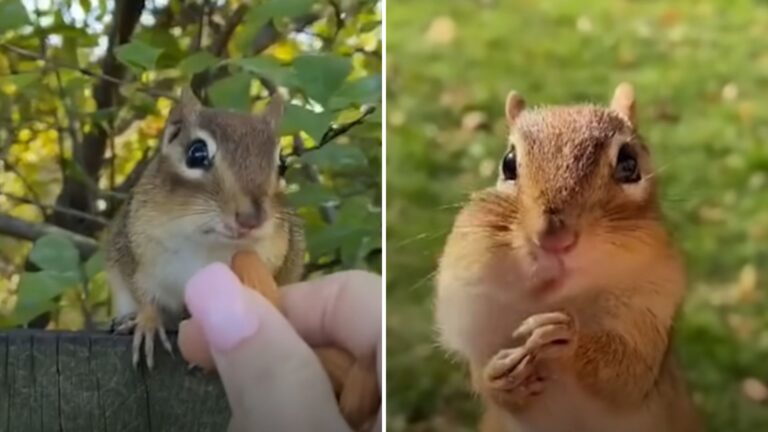These Are The Biggest Birds Ever Spotted In Each State
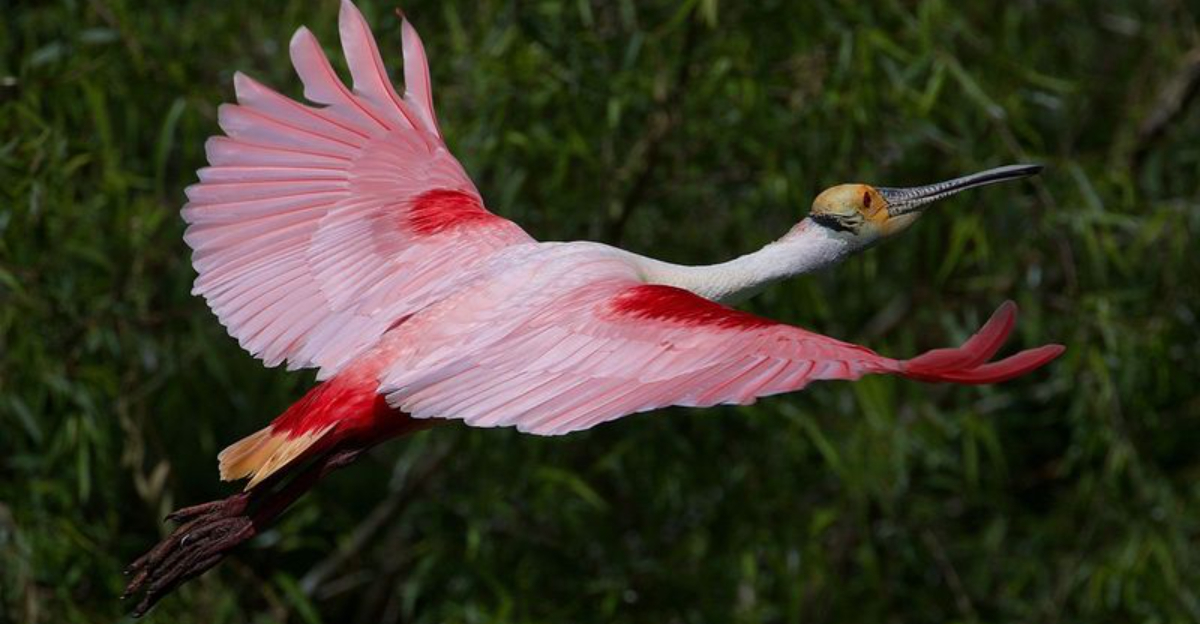
Across the United States, each state boasts its own distinct natural marvels, including avian giants. Today, we’ll take you on a journey from Alabama to Wyoming, showcasing the largest bird spotted in each state.
These majestic creatures, each with unique adaptations and fascinating traits, highlight the diverse habitats across the country. Prepare to be amazed by the imposing wingspans, vibrant plumage, and captivating behaviors of these feathered titans.
As we explore each state’s avian marvel, you’ll learn intriguing facts about their environments, diets, and the conservation efforts underway to protect these incredible species. So grab your binoculars and join us in discovering the largest birds that call each state their home.
1. California Condor In Arizona
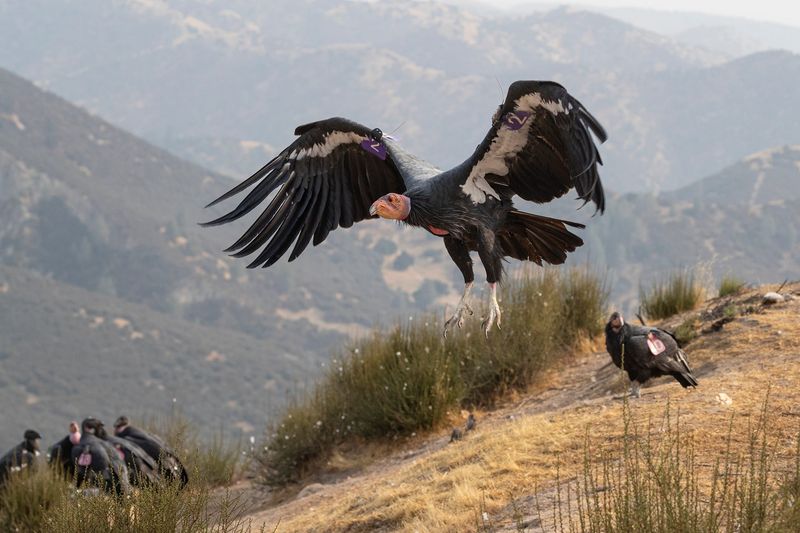
In Arizona, the California Condor reigns supreme as the largest bird. These extraordinary creatures boast wingspans stretching up to nine and a half feet, making them one of the largest flying birds in the world. Found primarily in the Grand Canyon area, these condors are a sight to behold as they glide effortlessly on thermal currents.
Efforts to reintroduce and conserve these magnificent birds have been ongoing for decades. With fewer than a hundred condors left in the wild in the 1980s, captive breeding programs have been crucial in restoring their population. Today, dedicated conservationists continue to monitor and protect these birds, ensuring they have a safe habitat to thrive.
The California Condor’s staple diet consists of carrion, which they locate using their keen eyesight from high altitudes. Observing one of these impressive birds in flight is a highlight for birdwatchers and nature enthusiasts alike. Their recovery story is a testament to conservation success, inspiring efforts to protect other endangered species. Experience the awe of witnessing a California Condor soaring over Arizona’s vast landscapes, a true symbol of nature’s resilience.
2. Sandhill Crane In Idaho
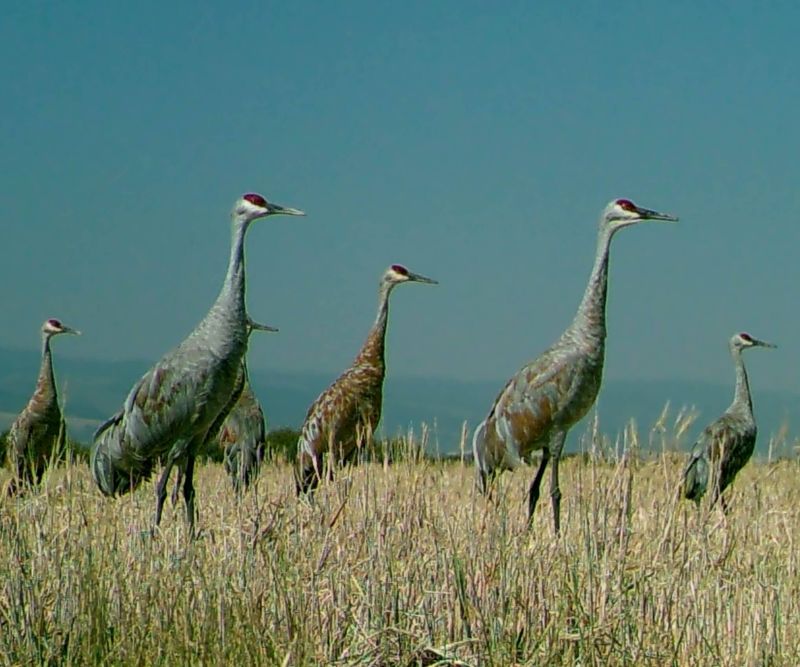
Idaho’s largest bird is the elegant Sandhill Crane, known for its distinctive red crown and long legs. These cranes are often spotted in wetland areas, where their presence adds a majestic touch to the landscape. Their impressive wingspan and graceful movements make them a favorite among birdwatchers.
Sandhill Cranes are renowned for their elaborate courtship dances, which involve complex choreography of bowing, jumping, and wing flapping. These displays are not only a crucial part of their mating rituals but also a spectacle to behold. During migration, these cranes can be seen in large flocks, creating a breathtaking sight against the backdrop of Idaho’s skies.
Their diet primarily consists of grains, insects, and small vertebrates, which they forage from fields and marshes. Conservation efforts in Idaho focus on maintaining suitable wetland habitats to support crane populations. Bird enthusiasts flock to events like the annual Sandhill Crane Festival to celebrate and observe these magnificent birds. With their distinctive calls echoing across the wetlands, the Sandhill Crane stands as a symbol of Idaho’s natural beauty and biodiversity.
3. Bald Eagle In Alaska
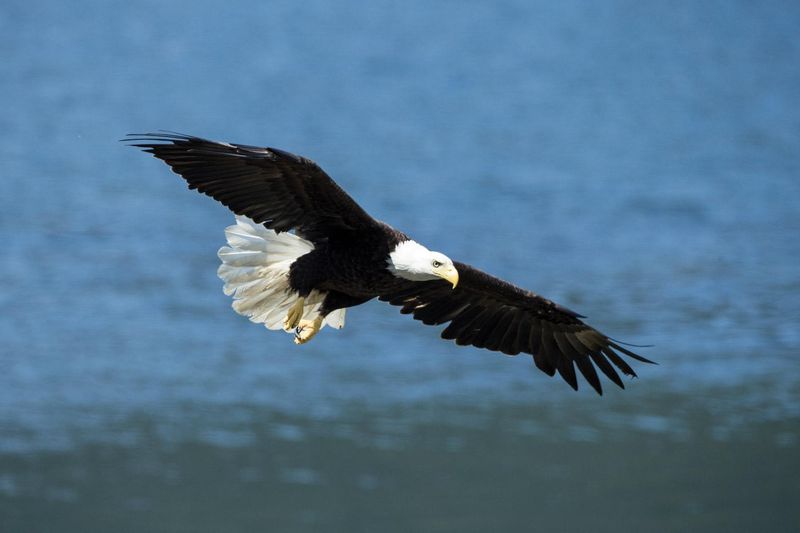
In the vast wilderness of Alaska, the Bald Eagle stands as the largest bird, exuding strength and grace. With its iconic white head and tail contrasting against a dark body, the Bald Eagle is a symbol of freedom and wilderness in the United States. Alaska is home to the highest population of these majestic birds.
Bald Eagles are often seen soaring over Alaska’s waterways, hunting for fish with incredible precision. Their keen eyesight allows them to spot prey from great distances, and their powerful talons ensure a firm grip once captured. Observing a Bald Eagle in its natural habitat is an unforgettable experience for nature lovers.
Conservation efforts have been successful in increasing Bald Eagle populations in Alaska, thanks to the protection of their habitats and a ban on harmful pesticides. These efforts have allowed Bald Eagles to thrive, continuing to inspire awe and admiration. The Bald Eagle’s presence in Alaska is a testament to the state’s rich natural heritage and the successful conservation measures that protect it.
4. Great Horned Owl In Florida
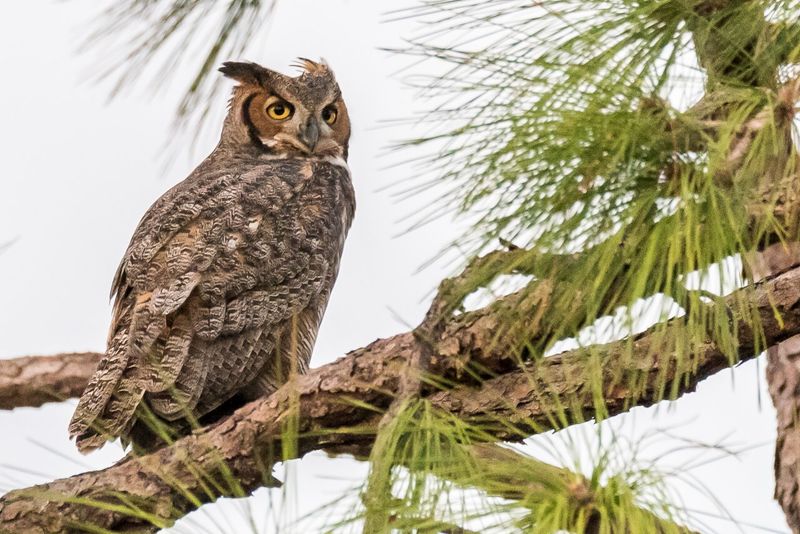
Florida’s largest bird, the Great Horned Owl, is a formidable predator with a distinctive appearance. Known for its prominent tufts and deep hoots, this owl commands attention in the diverse ecosystems of the state. Its adaptability allows it to thrive in various habitats, from forests to wetlands.
The Great Horned Owl is a skilled hunter, preying on a wide range of animals, including rodents, birds, and reptiles. Its silent flight and acute hearing make it an effective nocturnal predator. Birdwatchers in Florida often delight in spotting this owl, especially during its early evening hunts.
Conservation of the Great Horned Owl focuses on preserving its natural habitats and ensuring sufficient prey availability. These owls are a vital part of Florida’s ecosystem, controlling pest populations and maintaining ecological balance. With its striking appearance and impressive hunting skills, the Great Horned Owl captures the imagination of all who encounter it in the wild.
5. Whooping Crane In Texas
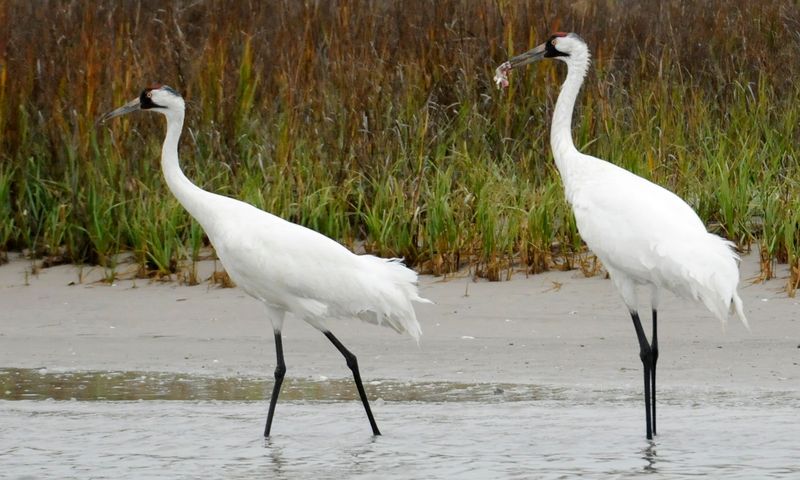
The Whooping Crane, the tallest bird in North America, is a remarkable sight in Texas. Known for its striking white plumage and distinctive red crown, the Whooping Crane is an emblem of conservation success. These graceful birds are typically found in coastal marshes and prairies, where they forage for food.
The Whooping Crane’s recovery from the brink of extinction is a testament to dedicated conservation efforts. With a population that once dwindled to just fifteen individuals in the wild, intensive breeding and habitat protection have been pivotal in their resurgence. Today, Texas serves as a critical wintering ground for these cranes.
These birds primarily feed on crustaceans, small fish, and aquatic plants. Birdwatchers flock to Texas’s Aransas National Wildlife Refuge to witness the majestic Whooping Crane in its natural habitat. The crane’s story of survival and growth is a powerful reminder of the importance of protecting endangered species and their habitats. Experiencing the Whooping Crane’s elegance in Texas is a celebration of nature’s resilience and beauty.
6. Trumpeter Swan In Minnesota
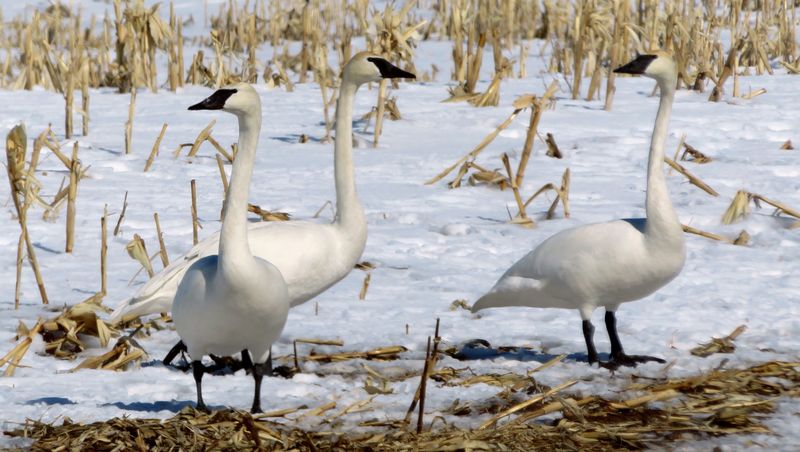
Minnesota’s largest bird, the Trumpeter Swan, is a symbol of grace and beauty. Known for its impressive wingspan and elegant white plumage, the Trumpeter Swan graces the state’s lakes and rivers. These birds are a favorite among birdwatchers for their serene presence and melodious calls.
Once on the brink of extinction, Trumpeter Swans have made a remarkable comeback in Minnesota. Conservation programs focusing on habitat restoration and protection have been instrumental in their recovery. Today, the sight of a Trumpeter Swan gliding across a tranquil lake is a testament to successful conservation efforts.
Trumpeter Swans feed on aquatic plants and small invertebrates, foraging in shallow waters. Their graceful movements and distinctive calls create a serene atmosphere, attracting nature enthusiasts to Minnesota’s waterways. The Trumpeter Swan’s story of survival is an inspiring example of how dedicated conservation can restore and preserve natural beauty for future generations.
7. Great Egret In Louisiana
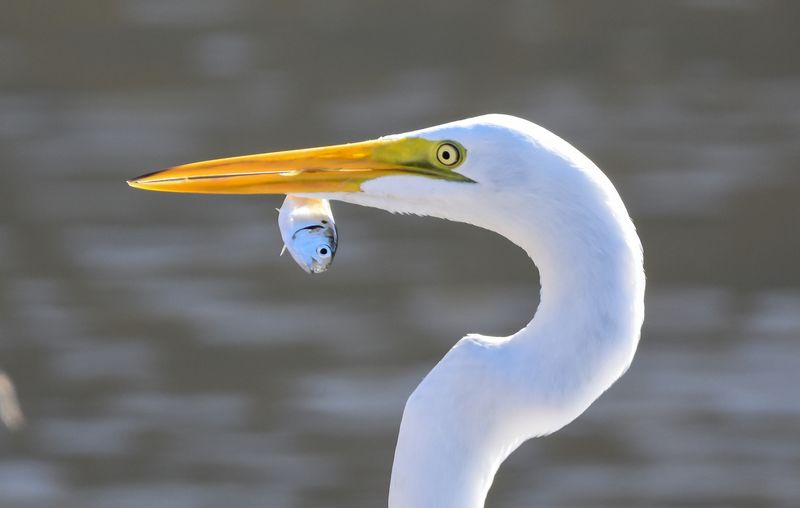
Louisiana’s largest bird, the Great Egret, is a stunning symbol of the state’s rich wetlands. Known for its striking white plumage and long, slender neck, the Great Egret is a picture of elegance as it wades through the bayous. These birds are often seen fishing in shallow waters, using their sharp beaks to catch small fish and amphibians.
Conservation efforts have played a crucial role in protecting the Great Egret’s habitat in Louisiana. Wetland preservation initiatives have ensured that these birds continue to thrive in their natural environment. The Great Egret’s graceful presence adds to the allure of Louisiana’s diverse ecosystems.
Their courtship displays, with elaborate feather plumes, are a sight to behold during the breeding season. Bird enthusiasts flock to Louisiana’s bayous to observe the Great Egret in its natural habitat, making it a highlight of any birdwatching adventure. The Great Egret’s beauty and elegance make it an enduring symbol of Louisiana’s natural charm.
8. Osprey In Maryland
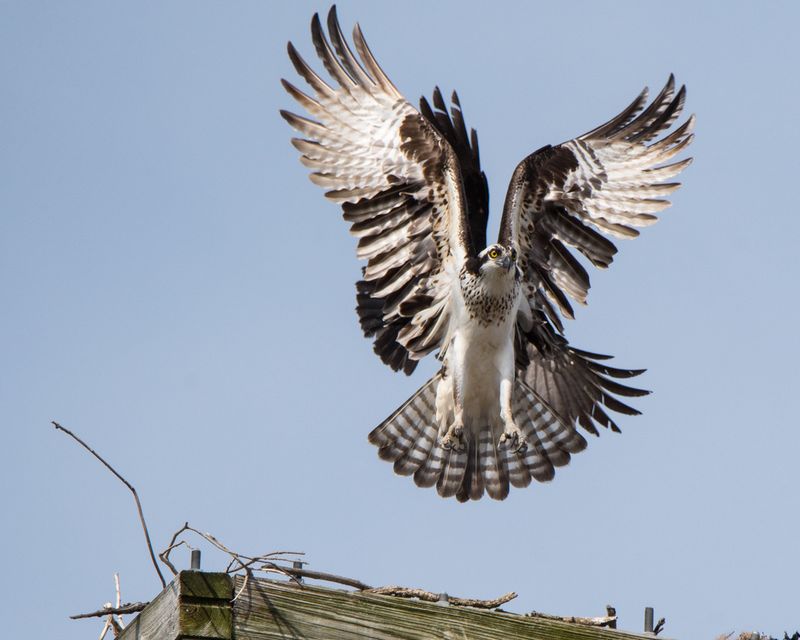
Maryland’s largest bird, the Osprey, is a master of fishing, known for its incredible diving skills and striking appearance. With a wingspan that impresses and a fierce gaze, the Osprey dominates the skies over Maryland’s waterways. Their diet consists almost exclusively of fish, which they capture with precision.
These birds are often seen near rivers and the Chesapeake Bay, where their fishing antics provide endless entertainment for onlookers. The Osprey’s ability to hover in place before plunging into the water is a remarkable display of avian acrobatics. Watching an Osprey in action is a highlight for any nature enthusiast visiting Maryland.
Conservation efforts have successfully increased Osprey populations in Maryland, focusing on preserving clean waterways and suitable nesting sites. These efforts ensure that the Osprey continues to thrive, adding to the state’s rich biodiversity. The Osprey’s presence is a testament to the health and vitality of Maryland’s aquatic ecosystems.
9. American White Pelican In North Dakota
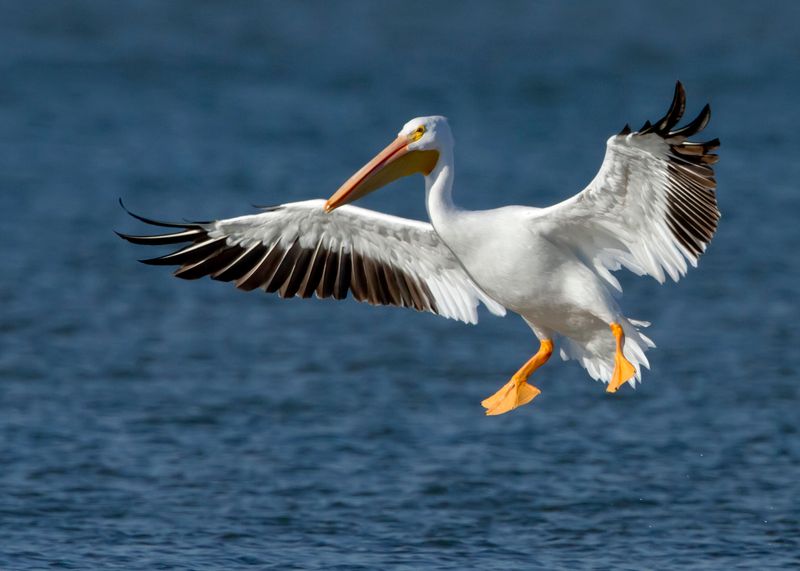
In North Dakota, the American White Pelican is the largest bird, captivating observers with its enormous wingspan and striking appearance. These pelicans are often seen in large flocks, their synchronized movements creating a mesmerizing sight over the state’s lakes and reservoirs.
The American White Pelican is known for its cooperative fishing strategies, where groups work together to herd fish into shallow waters for easier capture. This social behavior is fascinating to watch, showcasing their intelligence and teamwork. Birdwatchers in North Dakota are often thrilled by the sight of these pelicans gliding gracefully across the water.
Conservation efforts focus on protecting their nesting grounds and ensuring the availability of clean waterways. These initiatives have supported stable populations of American White Pelicans in North Dakota, allowing them to continue enchanting residents and visitors alike. The pelican’s majestic presence is a symbol of the state’s thriving natural habitats.
10. Ruffed Grouse In Pennsylvania
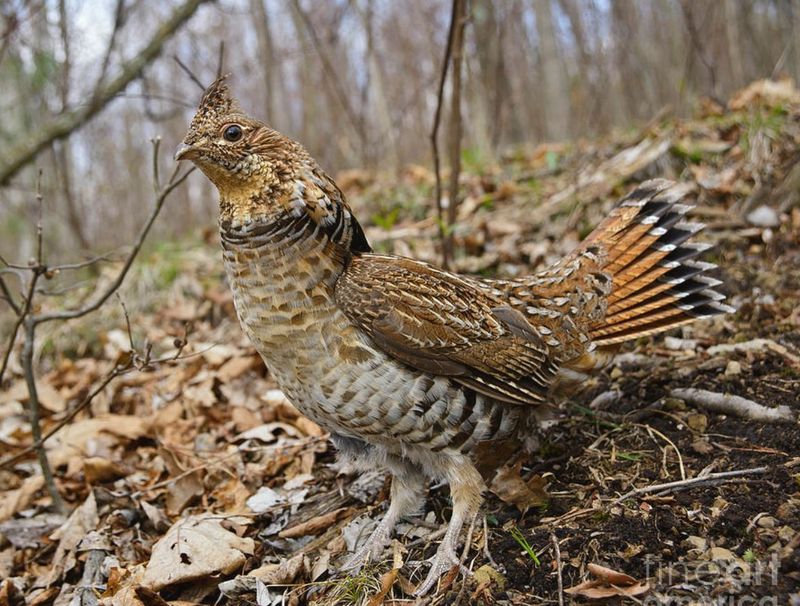
Pennsylvania’s largest bird is the Ruffed Grouse, a master of camouflage and an emblem of the state’s rich forests. Known for their fan-shaped tail and distinctive ‘drumming’ sounds, these birds create an enchanting presence in the woodlands.
The Ruffed Grouse’s ability to blend into its surroundings is remarkable, providing it with an effective defense against predators. During courtship, males perform an intriguing display, puffing out their neck ruffs and fanning their tails to attract females. This spectacle is a highlight for bird enthusiasts exploring Pennsylvania’s forests.
Conservation efforts focus on maintaining healthy forest habitats to support Ruffed Grouse populations. These birds play a crucial role in the ecosystem, aiding in seed dispersal and maintaining insect populations. The Ruffed Grouse’s presence in Pennsylvania is a testament to the state’s vibrant natural landscapes and the importance of preserving woodland environments.
11. Wild Turkey In Kentucky
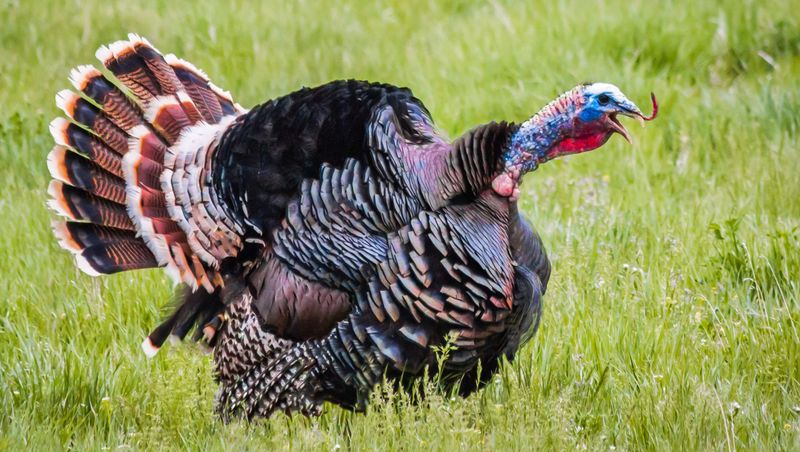
Kentucky’s largest bird, the Wild Turkey, is a symbol of the state’s rich natural heritage. Known for its iridescent plumage and distinctive fanned tail, the Wild Turkey is a familiar sight in Kentucky’s fields and forests.
These birds are highly adaptable, thriving in various habitats across the state. During the breeding season, male turkeys perform elaborate displays to attract females, showcasing their vibrant feathers and producing a series of gobbling sounds. This behavior is a captivating aspect of Kentucky’s wildlife, drawing birdwatchers and nature enthusiasts alike.
Conservation efforts have successfully increased Wild Turkey populations in Kentucky, focusing on habitat restoration and management. These initiatives ensure that Wild Turkeys continue to thrive, contributing to the state’s rich biodiversity. The presence of the Wild Turkey is a testament to Kentucky’s successful wildlife conservation practices and the beauty of its natural landscapes.
12. Brown Pelican In Louisiana
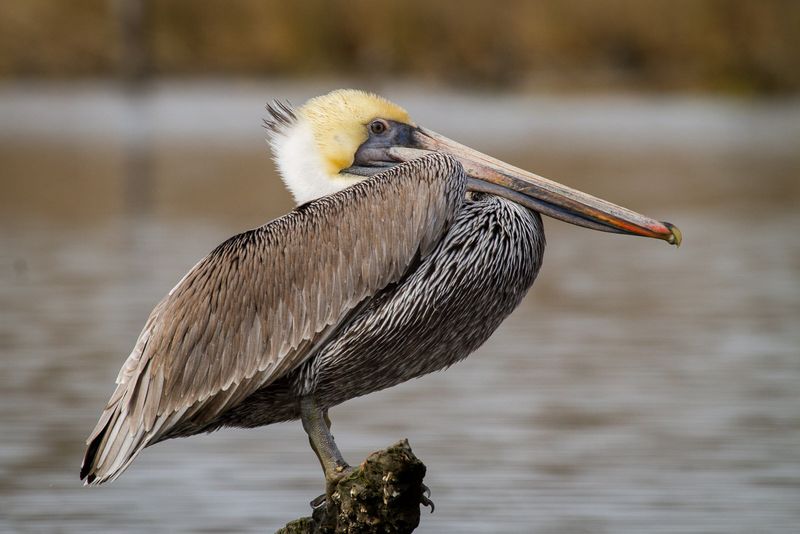
The Brown Pelican, Louisiana’s state bird, is a remarkable presence along the state’s coastal regions. Known for its expansive wingspan and distinctive light underbelly, the Brown Pelican is often seen gliding effortlessly over the Gulf of Mexico.
These pelicans are expert fishers, diving from heights to catch their prey with precision. Their cooperative hunting techniques and synchronized movements are a marvel to observe. The Brown Pelican’s impressive flight skills add to the allure of Louisiana’s coastal landscapes.
Conservation efforts have played a significant role in the recovery of Brown Pelican populations, focusing on habitat protection and pollution control. These initiatives have ensured that Brown Pelicans continue to thrive, contributing to the state’s rich biodiversity. The Brown Pelican’s presence in Louisiana is a testament to the successful conservation efforts that protect the state’s iconic wildlife.
13. Great Blue Heron In Virginia
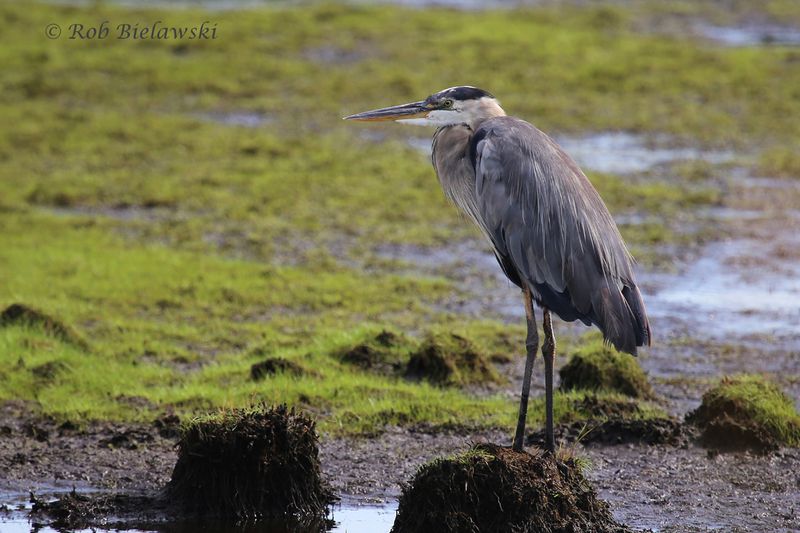
Virginia’s largest bird, the Great Blue Heron, is a striking presence in the state’s wetlands. Known for its long neck and gray-blue plumage, the Great Blue Heron cuts an elegant figure as it wades through the water in search of fish.
These herons are patient hunters, often standing motionless for long periods before striking with lightning speed to catch their prey. Birdwatchers in Virginia delight in observing the Great Blue Heron, especially during its graceful flight across the state’s skies.
Conservation efforts focus on protecting wetland habitats and ensuring clean waterways to support Great Blue Heron populations. These efforts have been successful in maintaining stable populations, allowing these majestic birds to thrive. The Great Blue Heron’s presence is a testament to the health and vitality of Virginia’s natural environments.
14. Mute Swan In New York
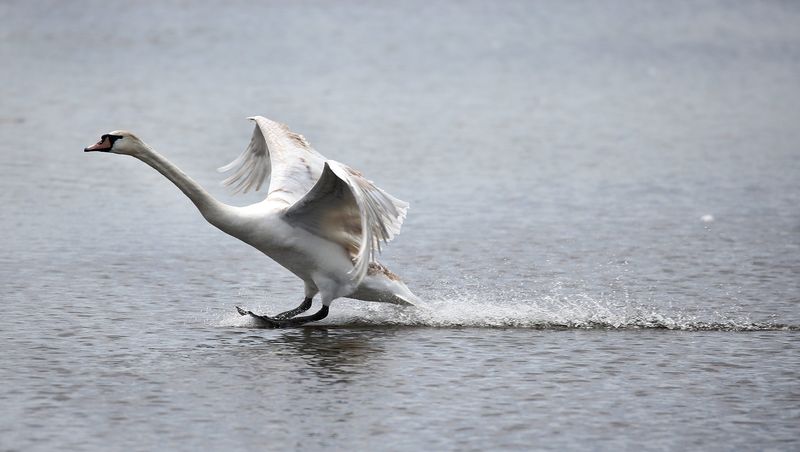
In New York, the largest bird is the Mute Swan, exuding elegance and grace with its pure white plumage and curved neck. These swans are a picturesque sight on New York’s lakes and ponds, captivating observers with their serene presence.
Mute Swans are known for their territorial behavior, often defending their nesting sites with fierce dedication. Their courtship displays, involving synchronized swimming and elegant posturing, are a highlight for birdwatchers. Observing a Mute Swan in its natural habitat is a calming experience, offering a glimpse into the beauty of New York’s landscapes.
Conservation efforts aim to balance the protection of native species with the management of Mute Swan populations, which can impact local ecosystems. These efforts ensure that New York’s natural habitats continue to thrive, supporting a diverse range of wildlife. The Mute Swan’s presence is a symbol of the state’s rich avian biodiversity.
15. Harpy Eagle In Hawaii
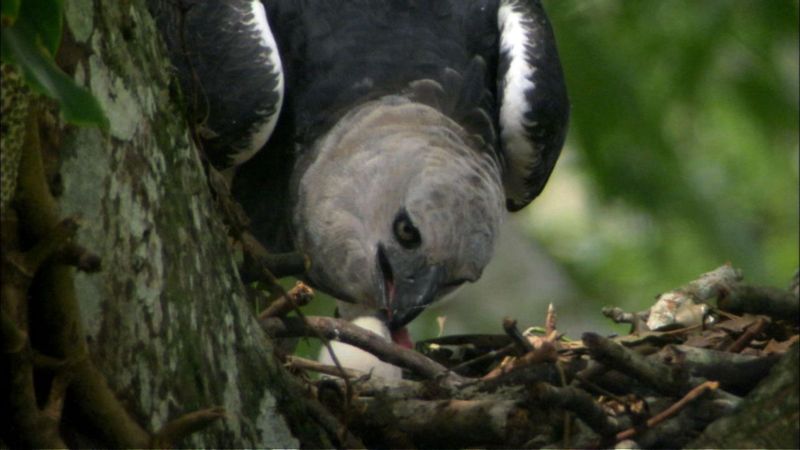
Hawaii’s largest bird, the Harpy Eagle, is a rare and formidable predator, known for its impressive size and powerful build. With a wingspan reaching up to seven feet, the Harpy Eagle dominates the skies with its presence.
These eagles are skilled hunters, preying on a variety of animals, including monkeys and sloths. Their powerful talons and keen eyesight allow them to capture prey with incredible precision. The Harpy Eagle’s role as an apex predator is essential for maintaining ecological balance in Hawaii’s forests.
Conservation efforts focus on protecting the Harpy Eagle’s natural habitats and ensuring the preservation of its prey species. These initiatives are crucial for maintaining healthy populations and preventing further decline. The Harpy Eagle’s presence in Hawaii is a testament to the island’s diverse and vibrant wildlife.
16. Red-Tailed Hawk In Illinois
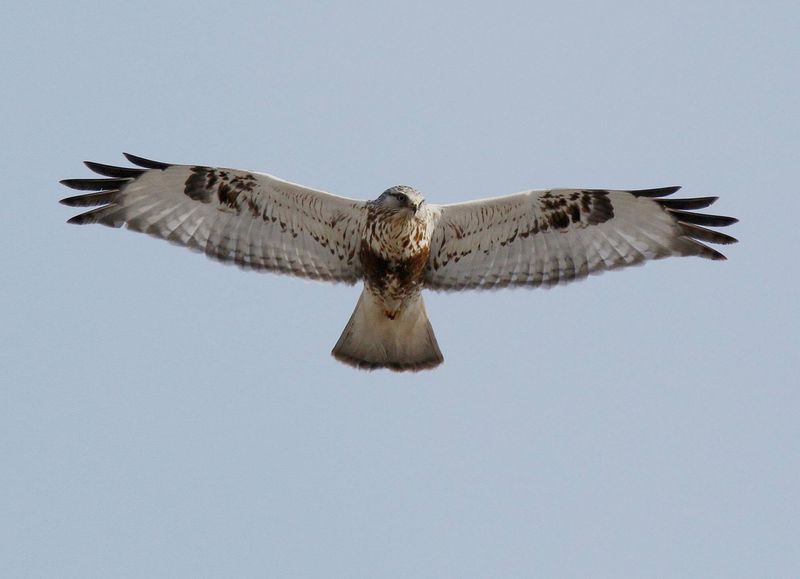
Illinois’s largest bird, the Red-tailed Hawk, is a majestic raptor known for its distinctive red tail and sharp gaze. These hawks are often seen soaring over the state’s prairies and forests, where they hunt for rodents and small mammals.
The Red-tailed Hawk’s keen eyesight allows it to spot prey from great distances, and its powerful talons ensure a successful capture. Birdwatchers in Illinois delight in observing these hawks, especially during their graceful flights and acrobatic displays.
Conservation efforts focus on preserving suitable habitats and ensuring the availability of prey species. These initiatives have been successful in maintaining stable populations of Red-tailed Hawks in Illinois. The presence of these raptors is a testament to the state’s rich natural landscapes and the importance of wildlife conservation.
17. Turkey Vulture In Ohio
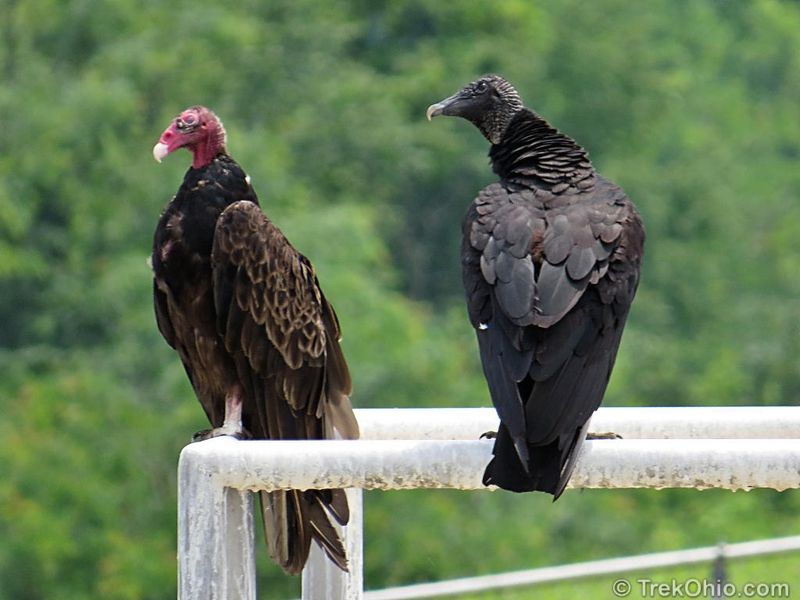
In Ohio, the Turkey Vulture stands as the largest bird, known for its broad wings and distinctive red head. These vultures are often seen soaring over the state’s countryside, utilizing thermal currents to effortlessly glide through the skies.
The Turkey Vulture plays a crucial role in the ecosystem as a scavenger, cleaning up carrion and preventing the spread of disease. Their keen sense of smell allows them to locate food from great distances, making them highly efficient scavengers.
Conservation efforts focus on protecting the Turkey Vulture’s natural habitats and ensuring safe environments free from human interference. These initiatives have been successful in maintaining stable populations, allowing these important birds to continue their ecological role. The Turkey Vulture’s presence in Ohio is a testament to the state’s diverse wildlife and healthy ecosystems.
18. American Crow In Michigan
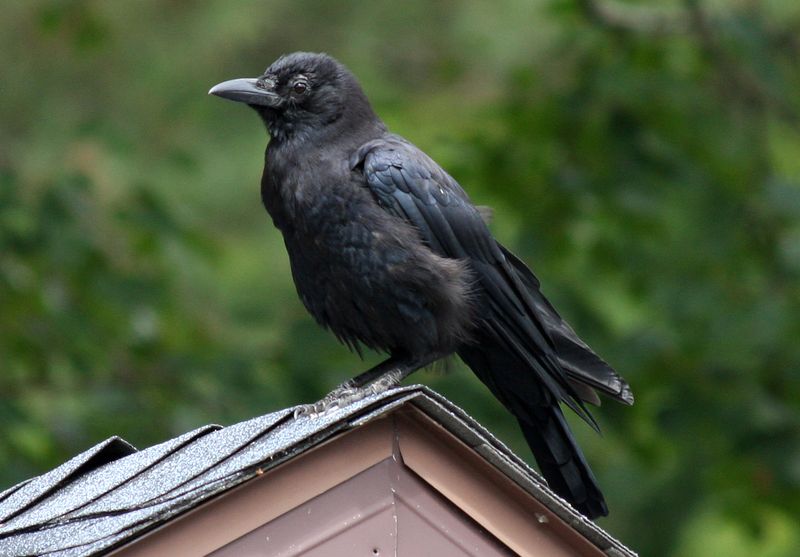
Michigan’s largest bird, the American Crow, is a highly intelligent and adaptable species known for its glossy black feathers and distinctive cawing calls. These crows are a common sight across the state’s landscapes, from urban areas to dense forests.
American Crows are highly social birds, often seen in large flocks, especially during the winter months. Their ability to communicate and problem-solve is fascinating, showcasing their intelligence and adaptability. Observing an American Crow in its natural habitat is a reminder of the complexity and diversity of Michigan’s avian life.
Conservation efforts focus on protecting the American Crow’s habitats and ensuring ample food sources. These initiatives have supported stable populations, allowing these intelligent birds to thrive. The presence of the American Crow is a testament to Michigan’s rich biodiversity and the importance of preserving natural habitats.
19. Mountain Bluebird In Nevada
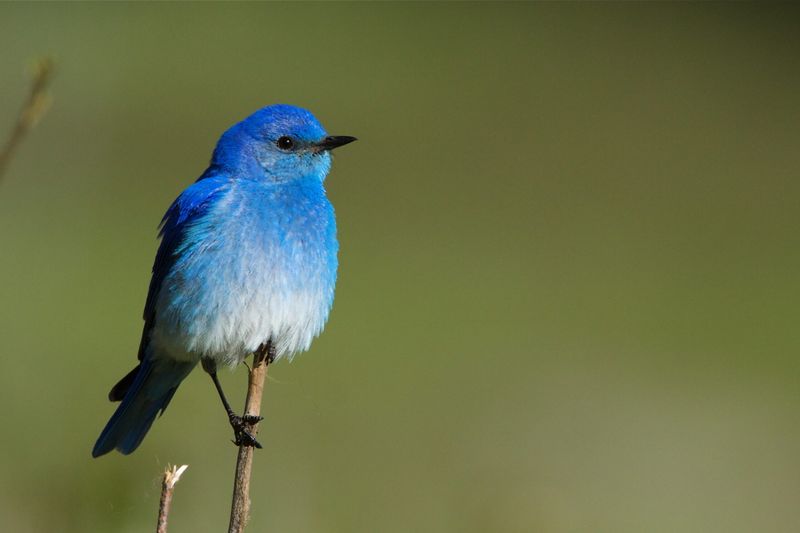
Nevada’s largest bird, the Mountain Bluebird, is a stunning sight with its vibrant blue feathers and cheerful songs. These birds grace Nevada’s open landscapes, adding a touch of color to the arid environment.
Mountain Bluebirds are highly adaptable, often found in meadows, grasslands, and even urban areas. Their diet primarily consists of insects and berries, which they forage with agility and precision. Birdwatchers in Nevada delight in observing the Mountain Bluebird, especially during its lively displays and melodious calls.
Conservation efforts focus on preserving suitable habitats and ensuring the availability of food sources. These initiatives have been successful in maintaining healthy populations of Mountain Bluebirds in Nevada. The presence of these birds is a testament to the state’s diverse ecosystems and the importance of wildlife conservation.
20. Wood Stork In Georgia
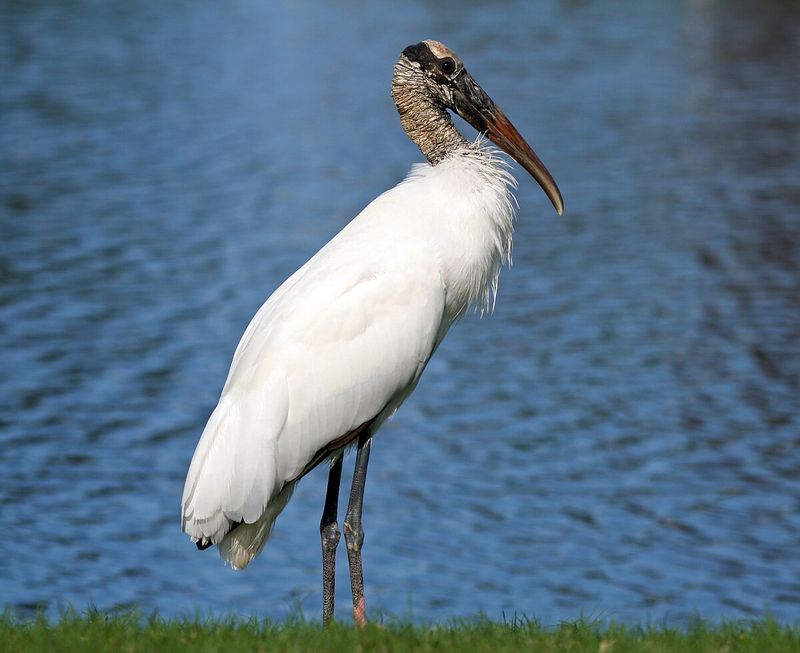
Georgia’s largest bird, the Wood Stork, is a unique and fascinating species, known for its distinctive bald head and long legs. These storks are often seen wading through Georgia’s swamps and wetlands, where they forage for fish and other aquatic prey.
The Wood Stork’s role in the ecosystem is vital, as they help control fish populations and contribute to the health of wetland habitats. Birdwatchers in Georgia are often captivated by the sight of these storks, especially during their graceful flight and foraging displays.
Conservation efforts have been successful in increasing Wood Stork populations, focusing on habitat protection and management. These initiatives have allowed Wood Storks to thrive, contributing to Georgia’s rich biodiversity. The presence of the Wood Stork is a symbol of the state’s successful wildlife conservation efforts and the beauty of its natural landscapes.
21. Peregrine Falcon In Connecticut
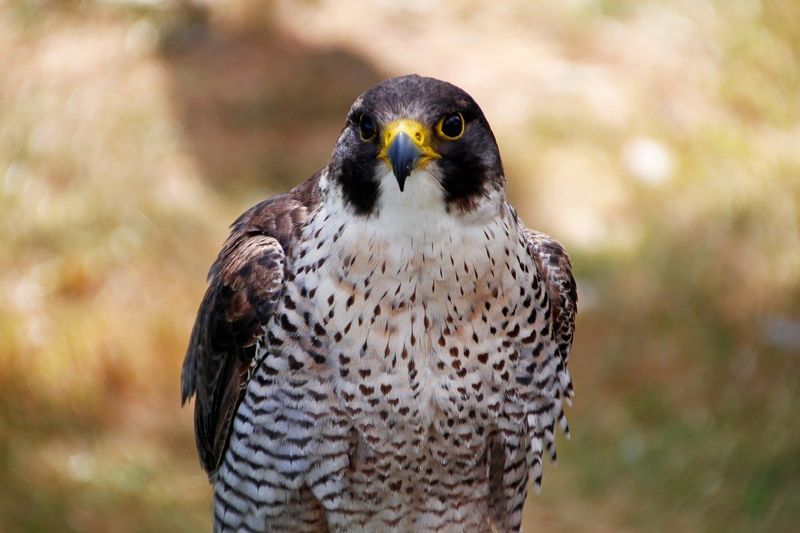
Connecticut’s largest bird, the Peregrine Falcon, is renowned for its incredible speed and agile flight. Known as the fastest bird in the world, these falcons are often seen diving through the state’s skies in pursuit of prey.
The Peregrine Falcon’s streamlined body and sharp talons make it a formidable predator, capable of capturing birds in mid-air with astonishing precision. Birdwatchers in Connecticut are thrilled by the sight of these falcons, especially during their thrilling high-speed hunts.
Conservation efforts have been critical in restoring Peregrine Falcon populations, focusing on protecting nesting sites and reducing environmental threats. These initiatives have been successful in ensuring stable populations, allowing these remarkable birds to continue their aerial displays. The Peregrine Falcon’s presence in Connecticut is a testament to the state’s commitment to wildlife conservation and the protection of its natural heritage.
22. Barn Owl In Missouri
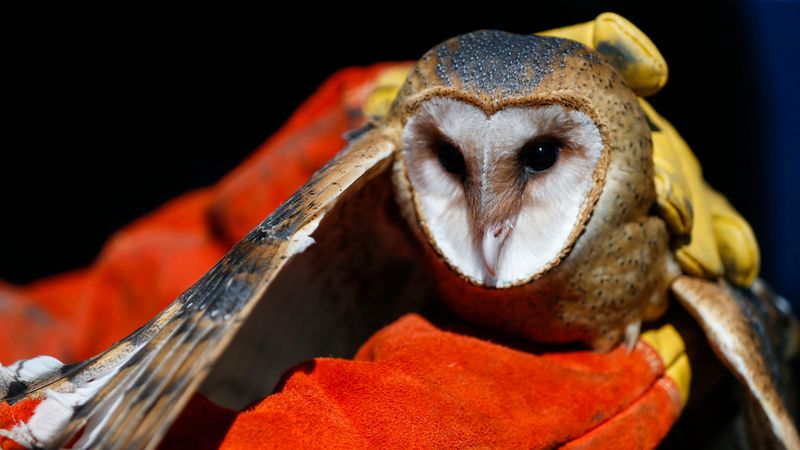
In Missouri, the largest bird is the Barn Owl, a mysterious and captivating creature known for its heart-shaped face and enigmatic nocturnal habits. These owls are often found in rural areas, where they roost in barns and outbuildings, adding a touch of mystery to the landscape.
The Barn Owl’s silent flight and acute hearing make it a highly efficient predator, targeting rodents and small mammals with precision. Birdwatchers in Missouri are often enchanted by the sight of these owls, especially during their silent hunts under the cover of darkness.
Conservation efforts focus on preserving suitable habitats and ensuring the availability of prey species. These initiatives have been successful in maintaining stable populations of Barn Owls in Missouri. The presence of these owls is a testament to the state’s rich wildlife and the importance of preserving natural habitats.
23. Roseate Spoonbill In Texas
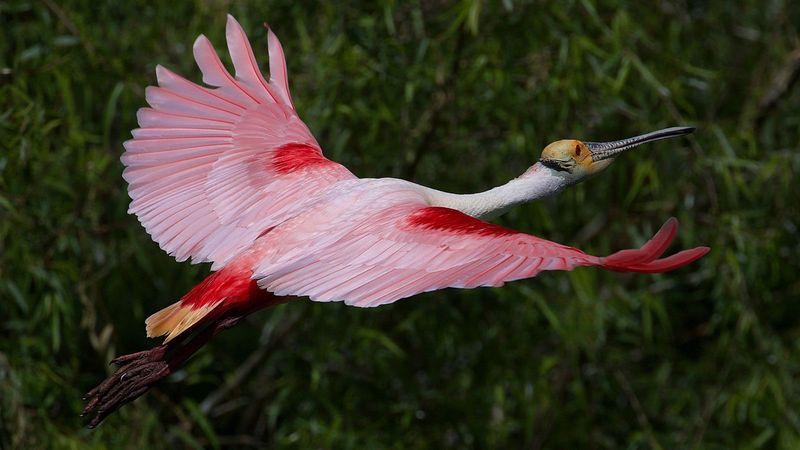
Texas is home to the vibrant Roseate Spoonbill, a striking bird known for its vivid pink plumage and unique spoon-shaped bill. This beautiful bird stands out in the wetlands and coastal areas of the state, where it feeds on small fish and crustaceans.
The Roseate Spoonbill’s feeding habits are fascinating to observe, as it uses its specialized bill to sift through mud and water in search of food. Birdwatchers in Texas are often delighted by the sight of these birds, especially during their graceful flights and social interactions.
Conservation efforts focus on protecting the Roseate Spoonbill’s habitats and ensuring the availability of food sources. These initiatives have been successful in maintaining healthy populations, allowing these vibrant birds to continue to thrive. The Roseate Spoonbill’s presence in Texas is a symbol of the state’s diverse wildlife and the beauty of its natural landscapes.
24. Northern Goshawk In New Hampshire
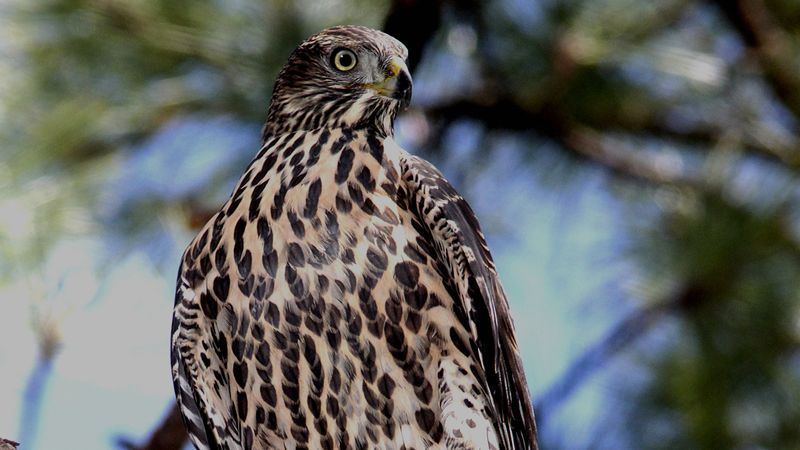
In New Hampshire, the largest bird is the Northern Goshawk, a powerful raptor known for its sharp gaze and striking gray plumage. These birds are often found in the state’s dense forests, where they hunt with incredible agility and speed.
The Northern Goshawk’s impressive hunting skills make it a formidable predator, capable of capturing a wide range of prey, including birds and small mammals. Birdwatchers in New Hampshire are often thrilled by the sight of these hawks, especially during their swift and agile flights.
Conservation efforts focus on preserving suitable habitats and ensuring the availability of prey species. These initiatives have been successful in maintaining stable populations of Northern Goshawks in New Hampshire. The presence of these raptors is a testament to the state’s rich natural landscapes and the importance of wildlife conservation.
25. Eastern Bluebird In Tennessee
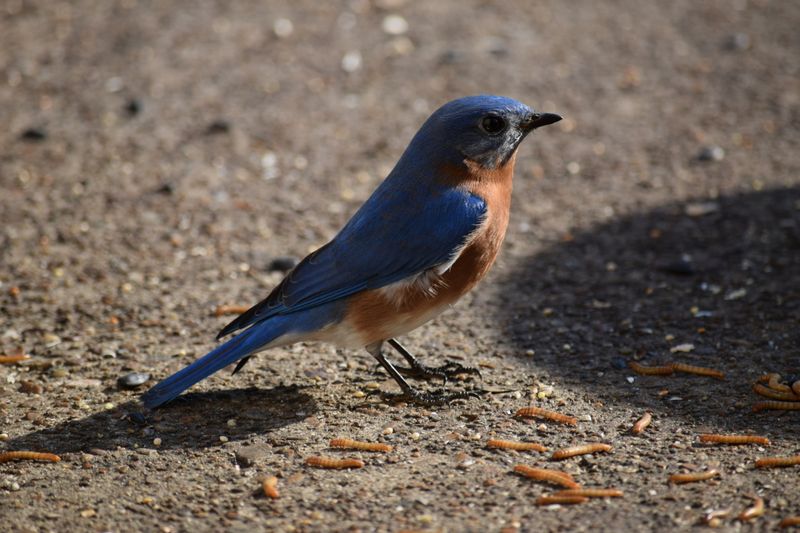
Tennessee’s largest bird, the Eastern Bluebird, is a symbol of happiness and prosperity, known for its striking blue and orange plumage. These birds grace Tennessee’s open fields and orchards, adding a splash of color to the landscape.
Eastern Bluebirds are highly social, often seen in pairs or small groups, communicating with cheerful songs and calls. Their diet primarily consists of insects and berries, which they forage with agility and precision. Birdwatchers in Tennessee delight in observing the Eastern Bluebird, especially during its courtship displays and nesting activities.
Conservation efforts focus on preserving suitable habitats and providing nesting sites, such as bluebird boxes, to support healthy populations. These initiatives have been successful in maintaining stable populations, allowing these vibrant birds to thrive. The presence of the Eastern Bluebird is a testament to Tennessee’s rich biodiversity and the importance of wildlife conservation.
26. Golden Eagle In Montana
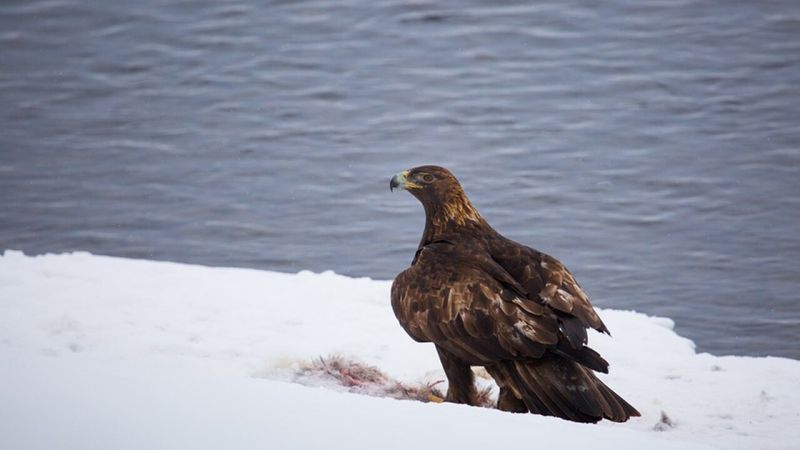
In Montana, the Golden Eagle reigns as the largest bird, a symbol of strength and majesty with its impressive wingspan and golden-brown plumage. These eagles are often seen soaring over the state’s rugged mountains and open plains, where they hunt for prey.
The Golden Eagle’s keen eyesight and powerful talons make it a formidable predator, capable of capturing a wide range of animals, including mammals and birds. Birdwatchers in Montana are often captivated by the sight of these eagles, especially during their graceful flights and powerful displays.
Conservation efforts focus on preserving suitable habitats and ensuring the availability of prey species. These initiatives have been successful in maintaining stable populations of Golden Eagles in Montana. The presence of these majestic birds is a testament to the state’s rich natural landscapes and the importance of wildlife conservation.
27. Eastern Kingbird In Massachusetts
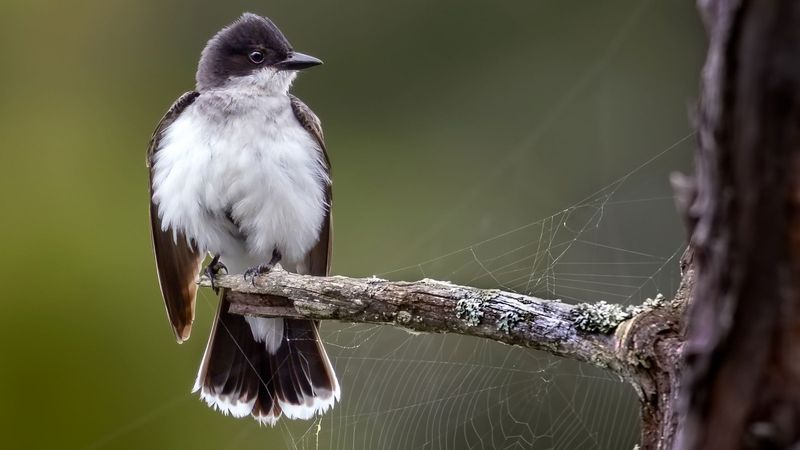
Massachusetts’s largest bird, the Eastern Kingbird, is a striking sight with its contrasting black and white plumage and bold behavior. These birds are often found in the state’s open fields and forests, where they hunt insects with agility and precision.
The Eastern Kingbird is known for its territorial nature, aggressively defending its nesting sites from larger birds and predators. Their aerial acrobatics and vocal calls are a highlight for birdwatchers in Massachusetts, especially during their spirited displays and interactions.
Conservation efforts focus on preserving suitable habitats and ensuring the availability of food sources. These initiatives have been successful in maintaining stable populations of Eastern Kingbirds in Massachusetts. The presence of these birds is a testament to the state’s rich biodiversity and the importance of wildlife conservation.
28. Cooper’s Hawk In Wisconsin
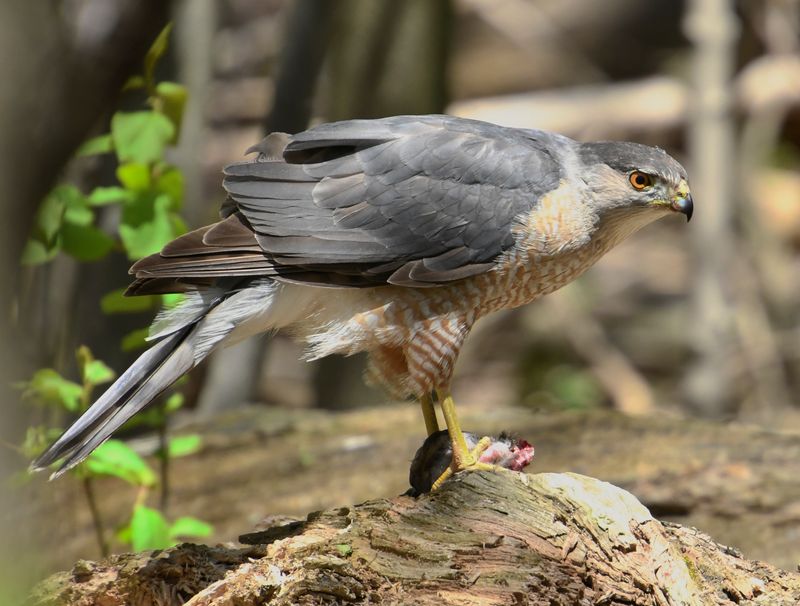
Wisconsin’s largest bird, the Cooper’s Hawk, is a formidable predator known for its sharp gaze and banded tail. These hawks are often found in the state’s forests and woodlands, where they hunt with incredible agility and speed.
The Cooper’s Hawk’s impressive hunting skills make it a formidable predator, capable of capturing a wide range of prey, including birds and small mammals. Birdwatchers in Wisconsin are often thrilled by the sight of these hawks, especially during their swift and agile flights.
Conservation efforts focus on preserving suitable habitats and ensuring the availability of prey species. These initiatives have been successful in maintaining stable populations of Cooper’s Hawks in Wisconsin. The presence of these raptors is a testament to the state’s rich natural landscapes and the importance of wildlife conservation.
29. Northern Pintail In California
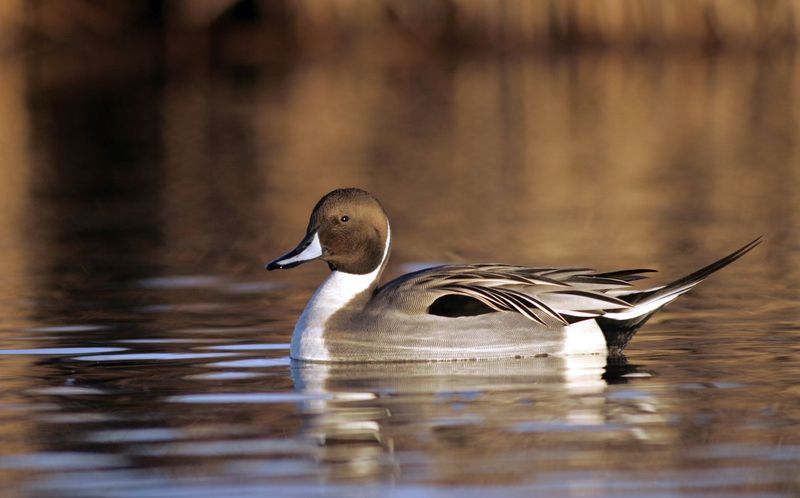
California’s largest bird, the Northern Pintail, is a symbol of elegance and grace with its long neck and striking plumage. These ducks are often seen in the state’s wetlands and coastal areas, where they forage for food.
Northern Pintails are known for their graceful movements and melodic calls, adding a serene atmosphere to California’s natural landscapes. Birdwatchers in California delight in observing these ducks, especially during their courtship displays and social interactions.
Conservation efforts focus on protecting the Northern Pintail’s habitats and ensuring the availability of food sources. These initiatives have been successful in maintaining stable populations, allowing these elegant birds to continue to thrive. The Northern Pintail’s presence in California is a testament to the state’s diverse wildlife and the beauty of its natural landscapes.
30. Brown Thrasher In Alabama
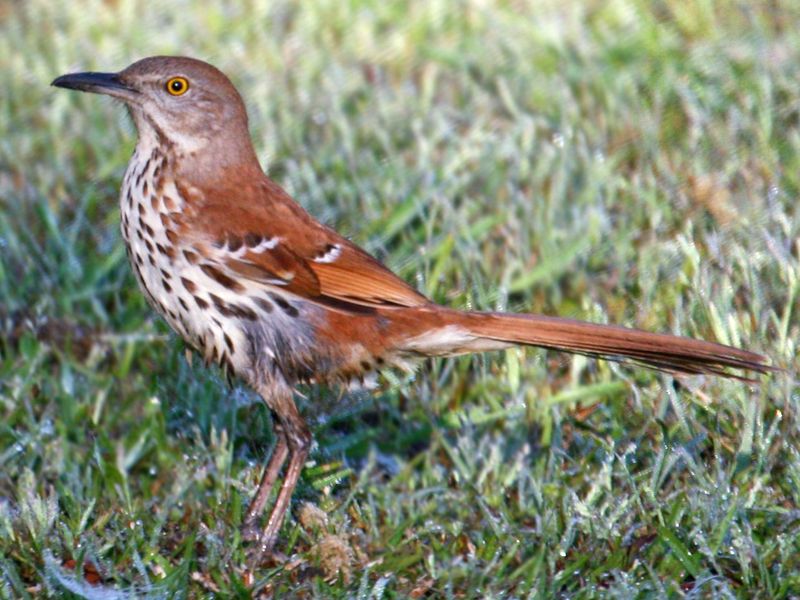
Alabama’s largest bird, the Brown Thrasher, is a charming presence in the state’s woodlands and gardens. Known for its russet plumage and bright yellow eyes, the Brown Thrasher is a skilled songbird, capable of mimicking a wide variety of sounds.
These thrashers are highly territorial, often defending their nesting sites with vigor. Their melodious songs and vocal repertoire make them a favorite among birdwatchers in Alabama, especially during the spring breeding season.
Conservation efforts focus on preserving suitable habitats and ensuring the availability of food sources. These initiatives have been successful in maintaining stable populations of Brown Thrashers in Alabama. The presence of these birds is a testament to the state’s rich avian biodiversity and the importance of wildlife conservation.
31. Scissor-Tailed Flycatcher In Oklahoma
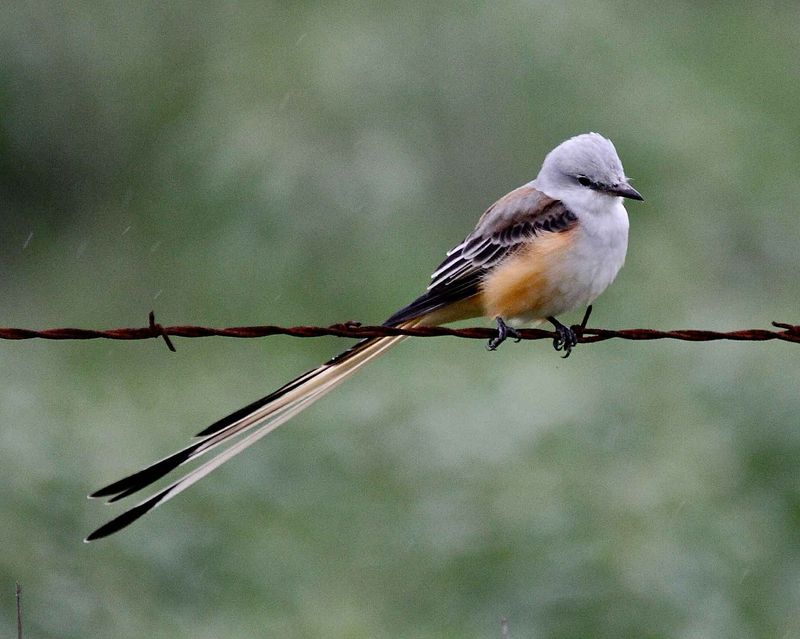
In Oklahoma, the largest bird is the Scissor-tailed Flycatcher, a striking sight with its long tail and distinctive plumage. These birds are often found in the state’s open fields and prairies, where they hunt insects with agility and precision.
The Scissor-tailed Flycatcher’s aerial acrobatics and vocal calls are a highlight for birdwatchers in Oklahoma, especially during their spirited displays and interactions. Their ability to maneuver through the air with ease is a testament to their agility and skill.
Conservation efforts focus on preserving suitable habitats and ensuring the availability of food sources. These initiatives have been successful in maintaining stable populations of Scissor-tailed Flycatchers in Oklahoma. The presence of these birds is a testament to the state’s rich biodiversity and the importance of wildlife conservation.
32. Pileated Woodpecker In Washington
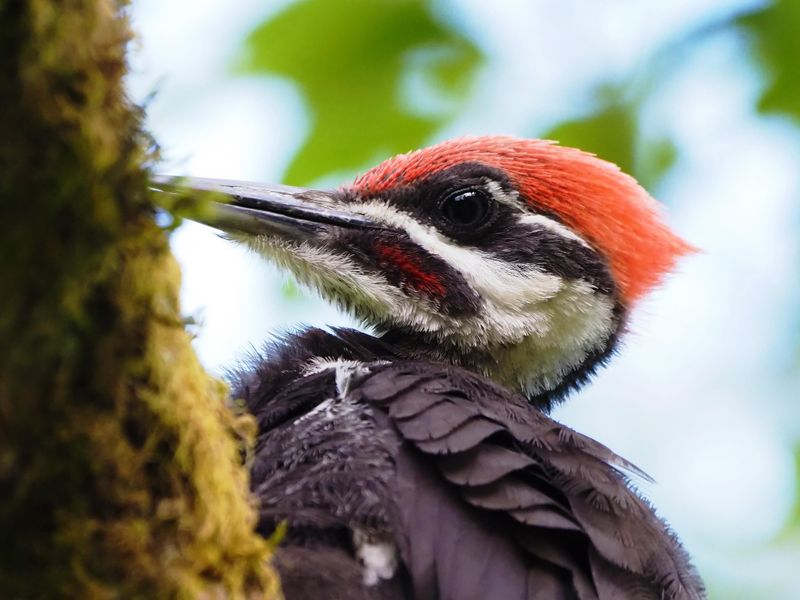
Washington’s largest bird, the Pileated Woodpecker, is a striking presence in the state’s forests. Known for its vibrant red crest and black-and-white plumage, the Pileated Woodpecker is a master carpenter of the avian world.
These woodpeckers are often seen clinging to tree trunks, where they excavate large cavities in search of insects. Their distinctive drumming sounds echo through Washington’s woodlands, announcing their presence to birdwatchers and nature enthusiasts alike.
Conservation efforts focus on preserving mature forests and ensuring the availability of suitable nesting sites. These initiatives have been successful in maintaining stable populations of Pileated Woodpeckers in Washington. The presence of these birds is a testament to the state’s rich natural landscapes and the importance of wildlife conservation.
33. Common Loon In Maine
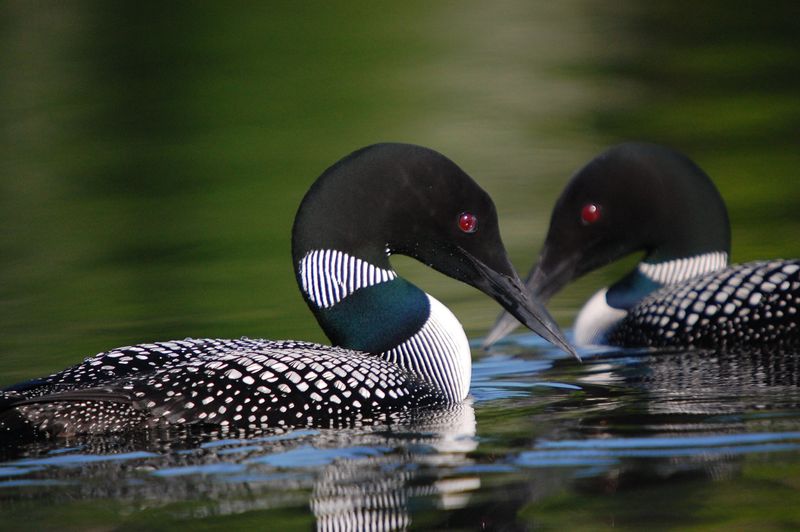
Maine’s largest bird, the Common Loon, is a captivating presence on the state’s lakes and ponds. Known for its striking black-and-white plumage and haunting calls, the Common Loon is a symbol of the state’s wild beauty.
These loons are expert divers, capable of reaching great depths in search of fish. Their powerful legs and webbed feet allow them to maneuver swiftly underwater, making them highly efficient hunters. Birdwatchers in Maine often delight in observing the Common Loon, especially during its mesmerizing courtship displays.
Conservation efforts focus on protecting nesting sites and ensuring the availability of clean waterways. These initiatives have been successful in maintaining stable populations, allowing these iconic birds to continue enchanting residents and visitors alike. The presence of the Common Loon is a testament to Maine’s rich natural heritage and the importance of wildlife conservation.
34. Broad-Winged Hawk In Vermont
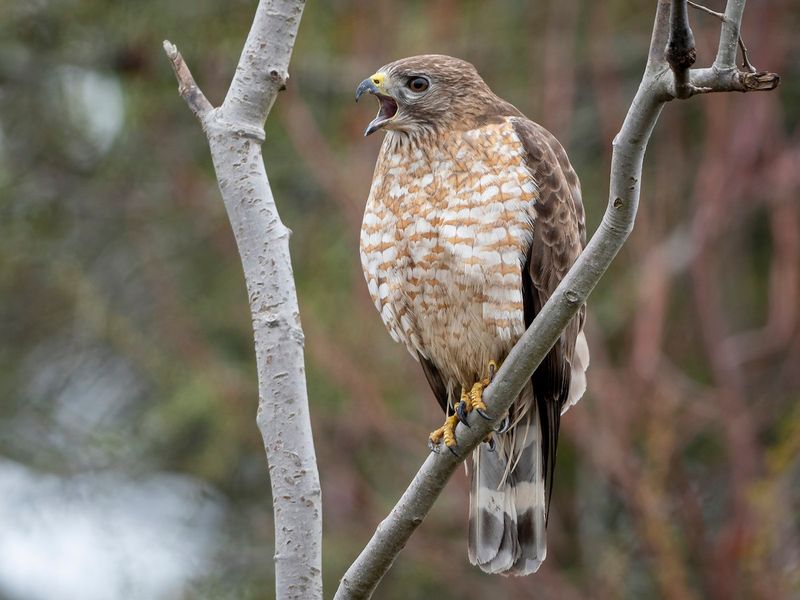
In Vermont, the largest bird is the Broad-winged Hawk, a majestic raptor known for its broad wings and distinctive tail pattern. These hawks are often seen soaring over the state’s forests, where they hunt for small mammals and reptiles.
The Broad-winged Hawk’s impressive flight skills and keen eyesight make it a formidable predator, capable of capturing prey with precision. Birdwatchers in Vermont are often captivated by the sight of these hawks, especially during their graceful flights and powerful displays.
Conservation efforts focus on preserving suitable habitats and ensuring the availability of prey species. These initiatives have been successful in maintaining stable populations of Broad-winged Hawks in Vermont. The presence of these raptors is a testament to the state’s rich natural landscapes and the importance of wildlife conservation.
35. Western Meadowlark In Kansas
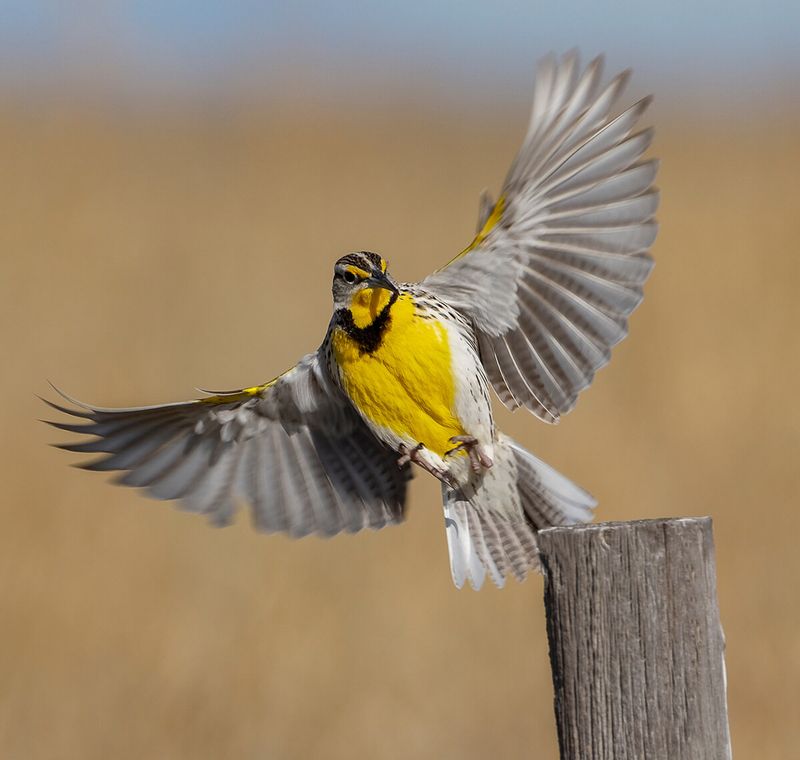
Kansas is home to the Western Meadowlark, a vibrant songbird known for its bright yellow underbelly and melodious calls. These birds grace the state’s prairies and open fields, adding a splash of color and music to the landscape.
Western Meadowlarks are highly territorial, often defending their nesting sites with a series of vocal displays. Their cheerful songs and vocal repertoire make them a favorite among birdwatchers in Kansas, especially during the spring breeding season.
Conservation efforts focus on preserving suitable habitats and ensuring the availability of food sources. These initiatives have been successful in maintaining stable populations of Western Meadowlarks in Kansas. The presence of these birds is a testament to the state’s rich avian biodiversity and the importance of wildlife conservation.
36. Belted Kingfisher In Indiana
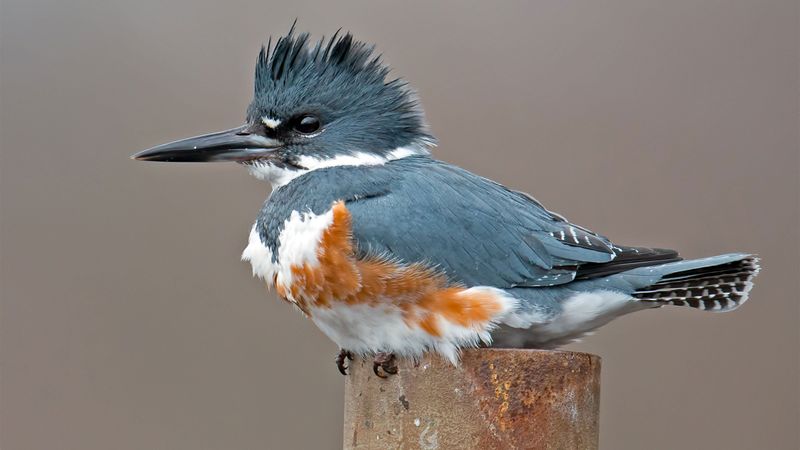
Indiana’s largest bird, the Belted Kingfisher, is a striking presence along the state’s waterways. Known for its distinctive blue-gray plumage and spiky crest, the Belted Kingfisher is a master fisherman, often seen diving into the water to catch fish.
These birds are solitary hunters, using their keen eyesight and sharp beaks to capture prey with precision. Birdwatchers in Indiana are often thrilled by the sight of these kingfishers, especially during their acrobatic dives and territorial displays.
Conservation efforts focus on preserving clean waterways and ensuring the availability of suitable nesting sites. These initiatives have been successful in maintaining stable populations of Belted Kingfishers in Indiana. The presence of these birds is a testament to the state’s rich natural landscapes and the importance of wildlife conservation.
37. American Kestrel In Arkansas
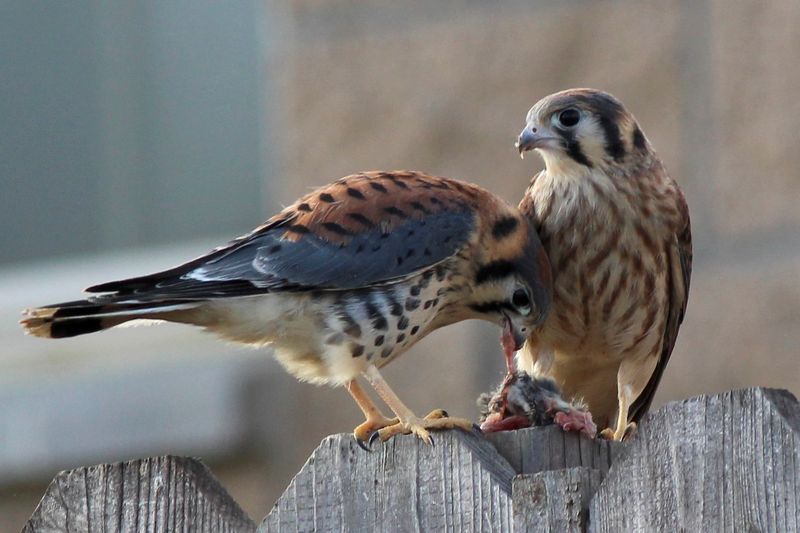
Arkansas is home to the American Kestrel, a small but formidable falcon known for its colorful plumage and sharp hunting skills. These kestrels are often seen perched on wires or poles, scanning the fields below for prey.
The American Kestrel’s keen eyesight and agile flight make it a highly efficient predator, capable of capturing insects and small mammals with precision. Birdwatchers in Arkansas are often captivated by the sight of these falcons, especially during their swift and agile flights.
Conservation efforts focus on preserving suitable habitats and ensuring the availability of prey species. These initiatives have been successful in maintaining stable populations of American Kestrels in Arkansas. The presence of these raptors is a testament to the state’s rich natural landscapes and the importance of wildlife conservation.
38. Eastern Towhee In Delaware
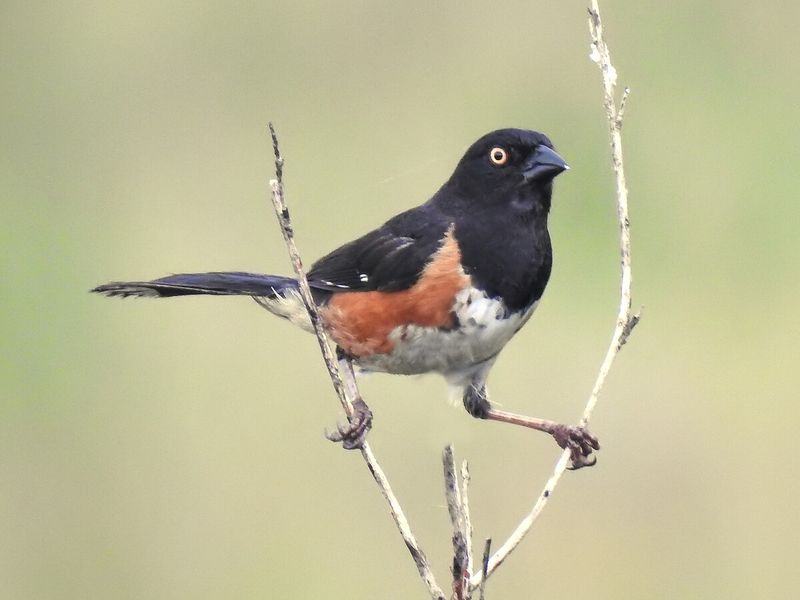
Delaware’s largest bird, the Eastern Towhee, is a striking presence in the state’s forests and gardens. Known for its striking black and orange plumage and distinctive two-part song, the Eastern Towhee is a favorite among birdwatchers.
These towhees are often seen foraging on the ground, using a characteristic ‘double-scratch’ technique to uncover insects and seeds. Their cheerful songs and vocal displays make them a highlight of any birdwatching adventure in Delaware.
Conservation efforts focus on preserving suitable habitats and ensuring the availability of food sources. These initiatives have been successful in maintaining stable populations of Eastern Towhees in Delaware. The presence of these birds is a testament to the state’s rich avian biodiversity and the importance of wildlife conservation.
39. Yellow-Headed Blackbird In South Dakota
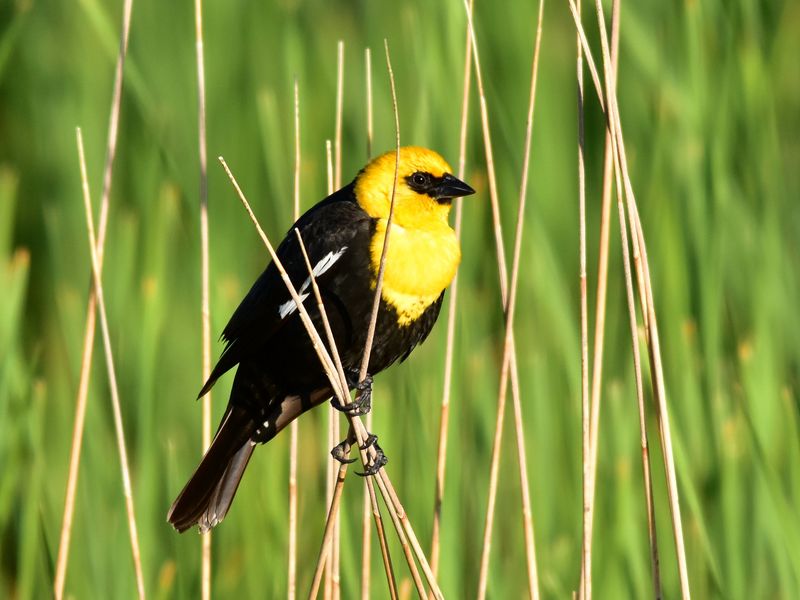
South Dakota is home to the Yellow-headed Blackbird, a striking species known for its vibrant yellow head and contrasting black body. These blackbirds are often seen in the state’s wetlands and marshes, where they forage for insects and seeds.
The Yellow-headed Blackbird’s loud and distinctive calls make it a standout presence in South Dakota’s landscapes. Birdwatchers often delight in observing these blackbirds, especially during their lively displays and social interactions.
Conservation efforts focus on preserving wetland habitats and ensuring the availability of food sources. These initiatives have been successful in maintaining stable populations of Yellow-headed Blackbirds in South Dakota. The presence of these birds is a testament to the state’s rich avian biodiversity and the importance of wildlife conservation.
40. American Bittern In Minnesota
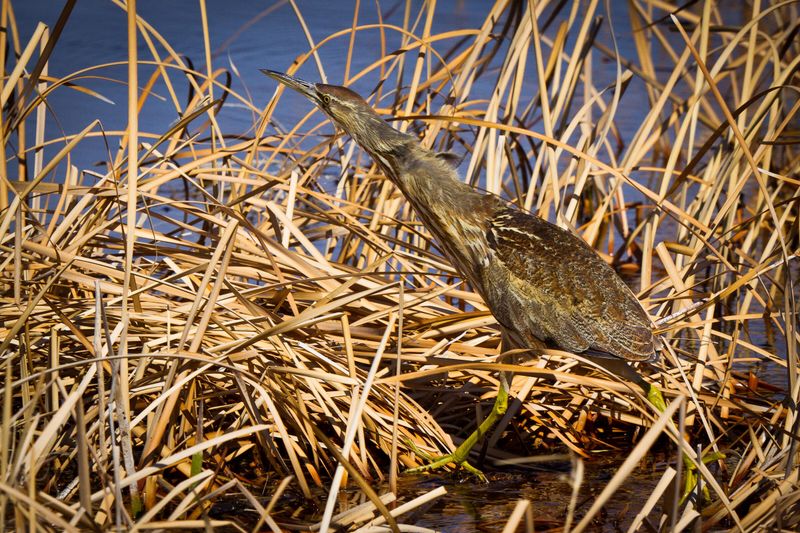
In Minnesota, the largest bird is the American Bittern, a master of camouflage known for its streaked brown plumage and distinctive ‘booming’ calls. These bitterns are often found in the state’s marshes and wetlands, where they hunt for fish and amphibians.
The American Bittern’s ability to blend into its surroundings is remarkable, providing it with an effective defense against predators. Birdwatchers in Minnesota often delight in the challenge of spotting these elusive birds, especially during their unique vocal displays.
Conservation efforts focus on preserving wetland habitats and ensuring the availability of food sources. These initiatives have been successful in maintaining stable populations of American Bitterns in Minnesota. The presence of these birds is a testament to the state’s rich natural landscapes and the importance of wildlife conservation.
41. Indigo Bunting In West Virginia
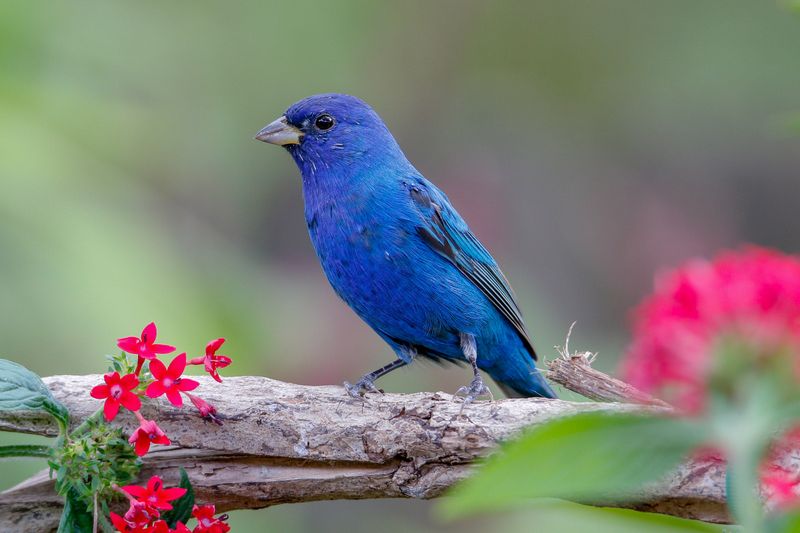
West Virginia’s largest bird, the Indigo Bunting, is a vivid presence with its vibrant blue plumage and cheerful songs. These buntings are often found in the state’s open fields and forests, where they forage for insects and seeds.
The Indigo Bunting’s melodious calls and striking appearance make it a favorite among birdwatchers in West Virginia, especially during the summer months. Observing these birds in their natural habitat is a joyful experience, offering a glimpse into the beauty of the state’s avian life.
Conservation efforts focus on preserving suitable habitats and ensuring the availability of food sources. These initiatives have been successful in maintaining stable populations of Indigo Buntings in West Virginia. The presence of these birds is a testament to the state’s rich biodiversity and the importance of wildlife conservation.
42. Great Black-Backed Gull In Maine
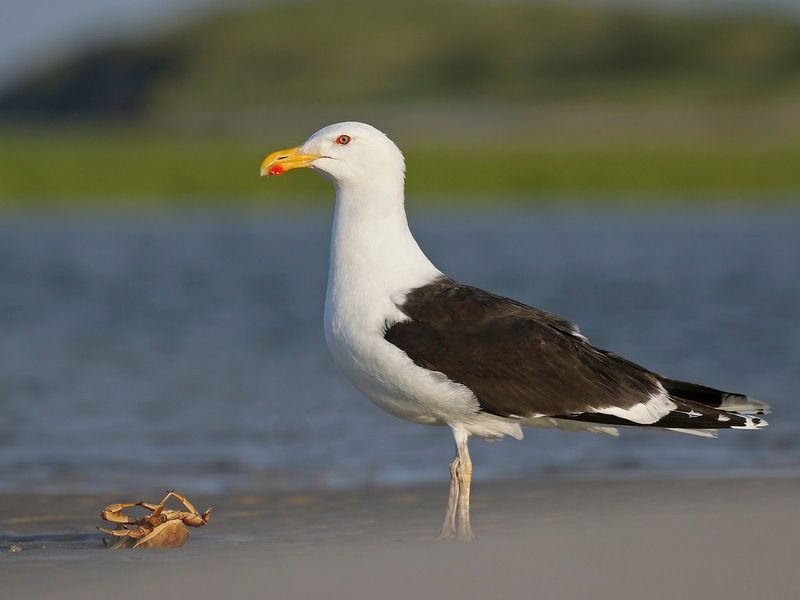
Maine is home to the Great Black-backed Gull, an impressive seabird known for its large size and distinctive black back. These gulls are often seen along the state’s rocky coastlines, where they feed on fish and marine invertebrates.
The Great Black-backed Gull’s powerful build and assertive nature make it a dominant presence in Maine’s coastal environments. Birdwatchers often delight in observing these gulls, especially during their dynamic interactions and feeding behaviors.
Conservation efforts focus on protecting coastal habitats and ensuring the availability of food sources. These initiatives have been successful in maintaining stable populations of Great Black-backed Gulls in Maine. The presence of these birds is a testament to the state’s rich marine biodiversity and the importance of coastal conservation.
43. Northern Cardinal In New Jersey
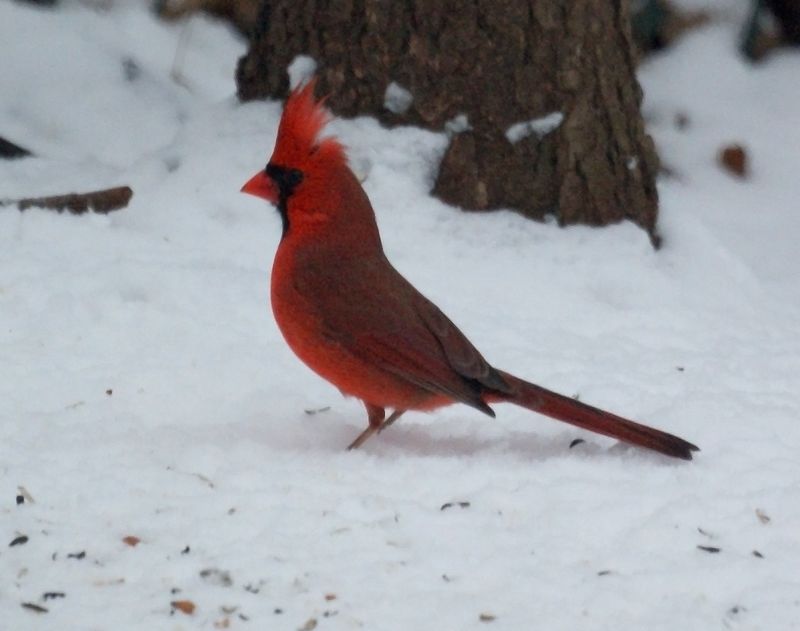
New Jersey’s largest bird, the Northern Cardinal, is a striking presence with its bright red plumage and distinctive crest. These cardinals are a familiar sight in the state’s gardens and woodlands, where they add a splash of color to the landscape.
Northern Cardinals are highly territorial, often seen defending their nesting sites with a series of vocal displays and physical posturing. Their cheerful songs and vibrant appearance make them a favorite among birdwatchers in New Jersey, especially during the spring breeding season.
Conservation efforts focus on preserving suitable habitats and ensuring the availability of food sources. These initiatives have been successful in maintaining stable populations of Northern Cardinals in New Jersey. The presence of these birds is a testament to the state’s rich avian biodiversity and the importance of wildlife conservation.
44. Red-Winged Blackbird In Iowa
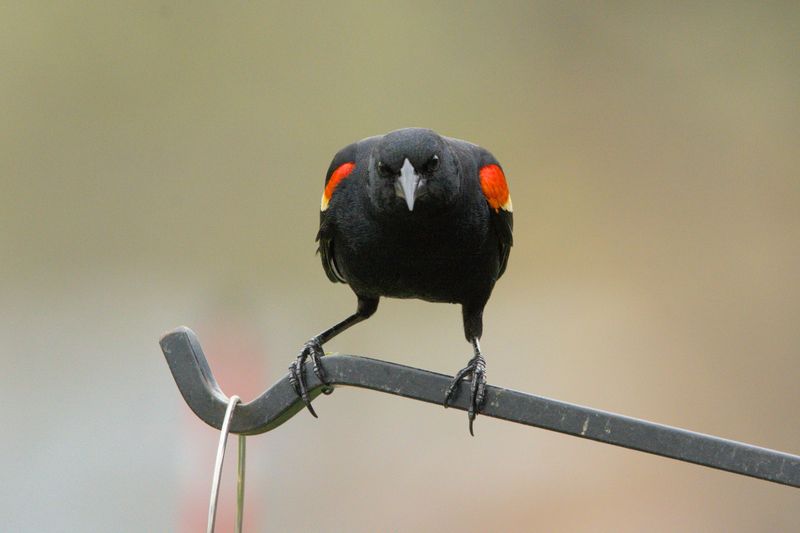
Iowa’s largest bird, the Red-winged Blackbird, is a vibrant presence in the state’s wetlands and marshes. Known for its striking red shoulder patches and distinctive calls, the Red-winged Blackbird is a familiar sight across Iowa’s landscapes.
These blackbirds are highly social, often seen in large flocks, especially during the breeding season. Their vocal displays and synchronized movements create a dynamic spectacle for birdwatchers in Iowa.
Conservation efforts focus on preserving wetland habitats and ensuring the availability of food sources. These initiatives have been successful in maintaining stable populations of Red-winged Blackbirds in Iowa. The presence of these birds is a testament to the state’s rich avian biodiversity and the importance of wildlife conservation.
45. Rock Ptarmigan In Alaska
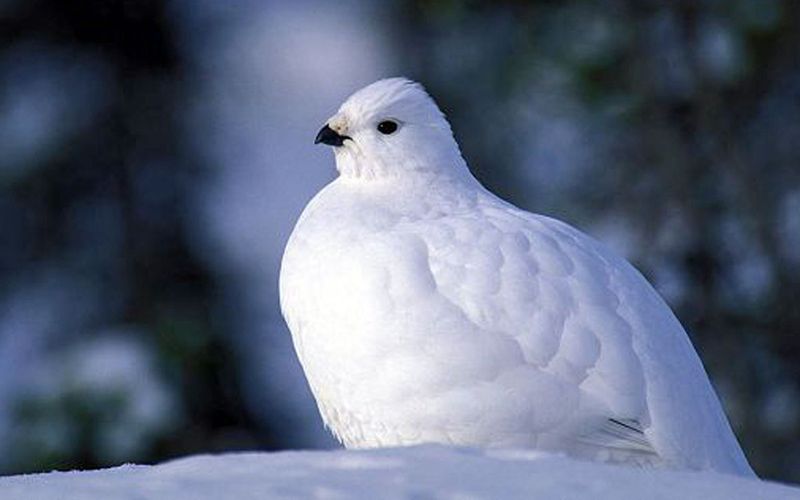
Alaska is home to the Rock Ptarmigan, a well-adapted species known for its seasonal camouflage and resilience to harsh climates. In winter, their plumage turns white to blend with the snowy landscape, while in summer, it shifts to brown tones to match the tundra.
These birds are often found in the state’s mountainous regions, where they forage for buds and insects. Birdwatchers in Alaska delight in observing the Rock Ptarmigan, especially during its seasonal transformations.
Conservation efforts focus on preserving suitable habitats and ensuring the availability of food sources. These initiatives have been successful in maintaining stable populations of Rock Ptarmigans in Alaska. The presence of these birds is a testament to the state’s diverse wildlife and the importance of habitat conservation.
46. Snowy Egret In South Carolina
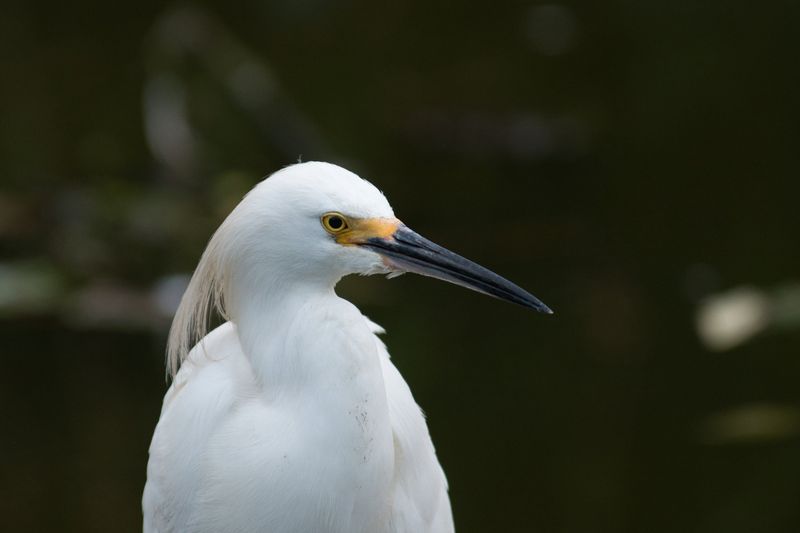
South Carolina’s largest bird, the Snowy Egret, is a picture of grace and beauty with its snowy white plumage and golden slipper-like feet. These egrets are often seen wading through the state’s marshes and tidal pools, where they hunt for fish and small aquatic creatures.
The Snowy Egret’s elegant movements and striking appearance make it a favorite among birdwatchers in South Carolina, especially during its graceful foraging displays. Observing these egrets in their natural habitat offers a glimpse into the beauty of the state’s coastal environments.
Conservation efforts focus on protecting wetland habitats and ensuring the availability of food sources. These initiatives have been successful in maintaining stable populations of Snowy Egrets in South Carolina. The presence of these birds is a testament to the state’s rich marine biodiversity and the importance of coastal conservation.
47. Common Raven In Utah
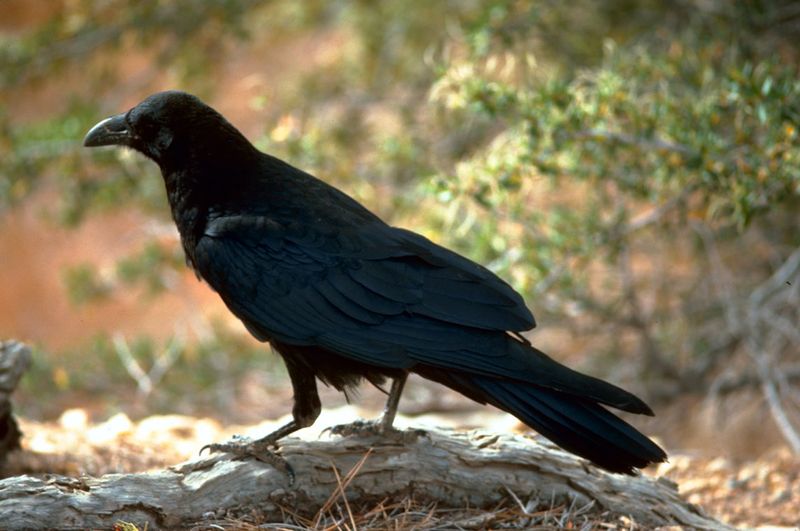
Utah’s largest bird, the Common Raven, is a highly intelligent and adaptable species known for its glossy black feathers and inquisitive nature. These ravens are a familiar sight across the state’s diverse landscapes, from deserts to mountainous regions.
Common Ravens are highly social birds, often seen in pairs or small groups, communicating with a wide range of vocalizations and displays. Their intelligence and problem-solving abilities are fascinating, making them a favorite among birdwatchers in Utah.
Conservation efforts focus on preserving suitable habitats and ensuring the availability of food sources. These initiatives have been successful in maintaining stable populations of Common Ravens in Utah. The presence of these birds is a testament to the state’s rich biodiversity and the importance of wildlife conservation.
48. Sandhill Crane In Nebraska
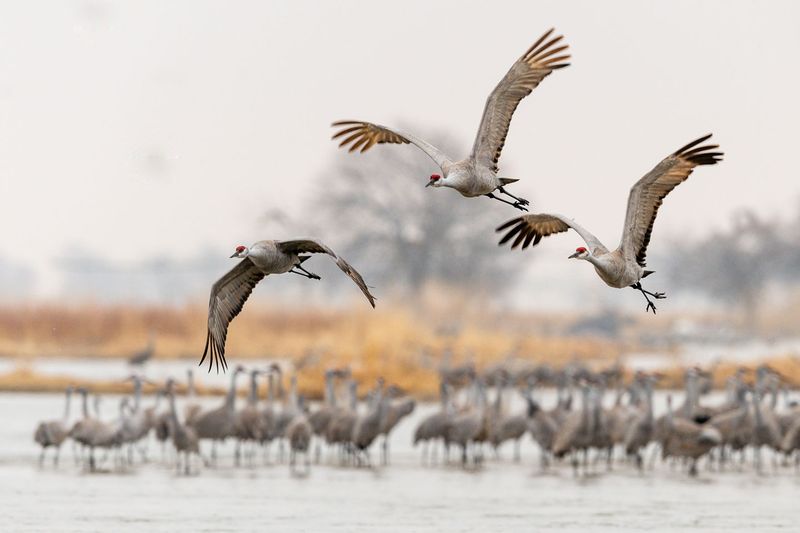
Nebraska’s largest bird, the Sandhill Crane, is a symbol of the state’s rich natural heritage with its distinctive red crown and long legs. These cranes are often seen in the state’s fields and wetlands, where they forage for grains and small animals.
Sandhill Cranes are known for their elaborate courtship dances, which involve synchronized movements and vocalizations. Their presence in Nebraska is a highlight for birdwatchers, especially during the annual migration when thousands of cranes gather in the state’s refuges.
Conservation efforts focus on preserving suitable habitats and ensuring the availability of food sources. These initiatives have been successful in maintaining stable populations of Sandhill Cranes in Nebraska. The presence of these birds is a testament to the state’s rich biodiversity and the importance of wildlife conservation.



